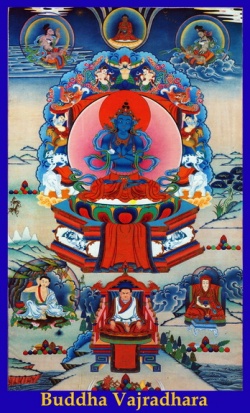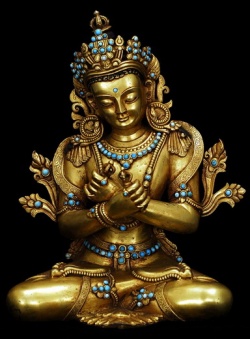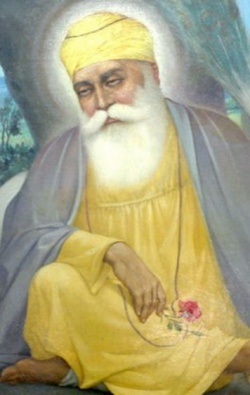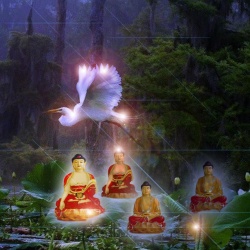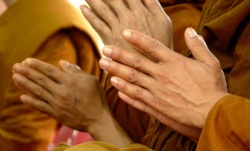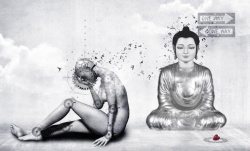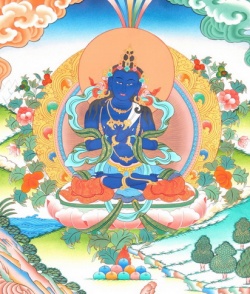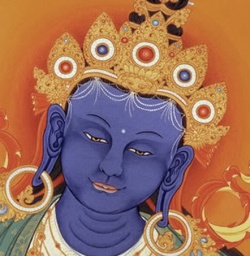Vajradhara
Vajradhara (Sanskrit : वज्रदेहर Vajradhāra, Tibetan : རྡོ་རྗེ་སེམས་དཔའ། rdo rje 'chang ; Ston pa rdo rje 'chang (Dorje Chang); Chinese : 多杰羌佛; Javanese: Kabajradharan; Japanese : 執金剛神; English: Diamond-holder) is the ultimate primordial Buddha , or Adi Buddha , according to the Gelug and Kagyu schools of Tibetan Buddhism .
Adi-Buddha
Thunderbolt-bearer
Symbol: Vajra thunderbolt, ghanta bell
Mudra: vajra-hum-kara
Color: dark blue
Shakti: Prajnaparamita
Vajradhara; Other names: Karmavajra, Dharmavajra.
Vajradhara is the supreme, primordial Buddha without beginning or end, lord of all mysteries, master of all secrets. It is to him the subdued and conquered evil spirits swear allegiance and vow that they will no longer prevent or hinder the propagation of the Buddhist faith. He is thought to be too ' great a god and too much lost in divine quietude to favour man's undertakings and works with his assistance, and that he acts through the god Vajrasattva, and would be to him in the relation of a Dhyani-Buddha to his human Buddha
He is always represented seated, with his legs locked and the soles of his feet apparent, and wears the Bodhisattva crown as well as the dress and ornaments of an Indian prince. He has the urna and ushnisha. His arms are crossed on his breast in the vajra-hum-kdra mudra holding the vajra and ghanta. These two symbols may, however, be supported by flowering branches on either side, the stems being held in the crossed hands, which is his special mystic gesture (v. PI. n, fig. b, and PI. in, fig. c).
As 'Karmavajra' (Dorje las) his left hand holds a lotus and his right hand is in vitarka (argument) mudra: arm bent, hand raised, palm turned outward, all fingers extended upward except the index and thumb which touch at the tips, called 'triangular pose' (v. vitarka).
As 'Dharmavajra' (Dorje c'os) his right hand balances a double vajra at his breast, and the left holds the bell on the hip.
When Vajradhara holds his sakti in yab-yum 14 attitude, his arms are crossed at her back, holding his usual symbols. The yum holds a vajra and kapala (skull-cup).
Vajradhara, the 'Indestructible', lord of all mysteries, master of all secrets, is an exoteric representation of Adi-Buddha, and in this form is believed to reign over the Easter Quarter. According to Mahayana school, it is to Vajradhara that the subdued and conquered evil spirits swear allegiance and renounce all active opposition to the Buddhist faith.
Certain Lamaist sects identified Vajradhara with Vajrasattva, while others looked upon Vajrasattva as an active form of Vajradhara, who was too lost in divine quietude to occupy him directly with the affairs of sentient beings. Others again worshipped Vajradhara as a supreme deity distinct and apart from Vajrasattva. The two greatest sects of Mahayana school: the dKar-hGyu-pa and the dGe-lugs-pa acknowledged Vajradhara as supreme, and looked upon as Adi-Buddha.
He is always represented seated, with lotus posture and wears the Boddhisattva crown as well as dress and ornaments. His arms are crossed on his breast in the vajra-hum-kara mudra holding the vajra and ghanta. He is in dark blue color.
Vajradhara is the primordial buddha, the dharmakaya buddha and is regarded as the highest deity in the Buddhist pantheon. Vajradhara, expresses the quintessence of buddhahood itself. Vajradhara represents the essence of the historical Buddha's realization of enlightenment.
Historically, Prince Siddhartha attained enlightenment under the bodhi tree in Bodhgaya over 2500 years ago and then manifested as the Buddha. According to Buddhist cosmology, he was the Fourth Historic Buddha of this fortunate eon. Prince Siddhartha's achievement of enlightenment, the realization, or wisdom of enlightenment itself, is called the dharmakaya, the body of truth. When he expresses that realization through subtle symbols, his realization is called the sambhogakaya, the body of enjoyment. When such realization manifested in more accessible or physical form for all sentient beings as the historical Shakyamuni Buddha, it is called the nirmanakaya, the body of manifestation.
The dharmakaya, synonymous with Vajradhara Buddha, is the source of all the manifestations of enlightenment. Vajradhara is central to the Kagyu lineage because Tilopa received the vajrayana teachings directly from Vajradhara, the dharmakaya buddha. Thus, the Kagyu lineage originated from the very nature of buddhahood.
Vajradhara is the primordial buddha, the dharmakaya buddha. Vajradhara, depicted as dark blue in color, expresses the quintessence of buddhahood itself. Vajradhara represents the essence of the historical Buddha's realization of enlightenment. Historically, Prince Siddhartha attained enlightenment under the bodhi tree in Bodhgaya over 2500 years ago and then manifested as the Buddha. According to Buddhist cosmology, he was the Fourth Historic Buddha of this fortunate eon. Prince Siddhartha's achievement of enlightenment, the realization, or wisdom of enlightenment itself, is called the dharmakaya, the body of truth.
Vajradhara (rdo rje 'chang). 'Vajra-holder.' The dharmakaya buddha of the Sarma Schools. Also used as a honorific title for great Vajrayana teachers.
adapted from "Vajradhara" on [1]
Vajradhara is the primordial Buddha, the Dharmakaya Buddha. Vajradhara, depicted as dark blue in colour, expresses the quintessence of buddhahood itself. Thus, Vajradhara represents the essence of the historical Buddha's realization of enlightenment.
Historically, in our time and age, Prince Siddhartha demonstrated the attainment of enlightenment under the bodhi tree in Bodhgaya over 2500 years ago, and then became known far and wide as the Buddha, the Awakened One. According to buddhist reckoning, he was the fourth historic Buddha of this fortunate eon, in which a thousand Buddhas are to appear. Prince Siddhartha's achievement of enlightenment, the realization, or wisdom of enlightenment itself, is called the Dharmakaya, the body of truth. When he expresses that realization through subtle symbols, his realization is called the Sambhogakaya, the body of enjoyment. When such realization manifests in a more accessible or physical form for all sentient beings, as the historical Shakyamuni Buddha for instance, it is called the Nirmanakaya, the body of manifestation.
The Dharmakaya, synonymous with Vajradhara Buddha, is the source of all the manifestations of enlightenment. As such, the Buddha has often manifested in the shape of Vajradhara to many early buddhist masters. For instance Tilopa and Niguma have had visionary experiences of Vajradhara, in the course of which they received crucial instructions. Thus, Vajradhara is often counted as the originator of many of the Sarma Schools, or schools of the later dissemination of the buddhist teachings in Tibet.
When he expresses that realization through subtle symbols, his realization is called the sambhogakaya, the body of enjoyment. When such realization manifested in more accessible or physical form for all sentient beings as the historical Shakyamuni Buddha, it is called the nirmanakaya, the body of manifestation. The dharmakaya, synonymous with Vajradhara Buddha, is the source of all the manifestations of enlightenment. Vajradhara is central to the Kagyu lineage because Tilopa received the vajrayana teachings directly from Vajradhara, the dharmakaya buddha. Thus, the Kagyu lineage originated from the very nature of buddhahood. That realization of the nature was in turn transmitted within the Golden Rosary by Tilopa
Symbol : Vajra (thunderbolt), ghanta (bell)
Mudra : vajra-hum-kara
Color: dark blue
Shakti : Prajnaparamita
VAJRADHARA is the primordial Buddha . It is also an honorific title reserved for the very seniormost masters , such as Jamyang Khyentse Chökyi Lodrö. Vajradhara is the founder of Vajrayana Buddhism , or Tantra . He is the same mental continuum as Buddha Shakyamuni but displays a different aspect.
He appeared as Buddha Shakyamuni to reveal the stages of the path of Sutra , and as Conqueror Vajradhara to reveal the stages of the path of Tantra .
Vajradhara said that in degenerate times he would appear in an ordinary form as a Spiritual Guide.
Vajradhara represents the essence of the historical Buddha 's realization of enlightenment .
Historically, in our time and age, Prince Siddhartha demonstrated the attainment of enlightenment under the bodhi tree in Bodhgaya over 2500 years ago, and then became known far and wide as the Buddha , the Awakened One . According to buddhist reckoning, he was the fourth historic Buddha of this fortunate eon, in which a thousand Buddhas are to appear. Prince Siddhartha 's achievement of enlightenment , the realization , or wisdom of enlightenment itself, is called the Dharmakaya , the body of truth . When he expresses that realization through subtle symbols , his realization is called the Sambhogakaya , the body of enjoyment. When such realization manifests in a more accessible or physical form for all sentient beings , as the historical Shakyamuni Buddha for instance, it is called the Nirmanakaya , the body of manifestation.
The Dharmakaya , synonymous with Vajradhara Buddha , is the source of all the manifestations of enlightenment . As such, the Buddha has often manifested in the shape of Vajradhara to many early buddhist masters . For instance Tilopa and Niguma have had visionary experiences of Vajradhara , in the course of which they received crucial instructions. Thus, Vajradhara is often counted as the originator of many of the Sarma Schools, or schools of the later dissemination of the buddhist teachings in Tibet .
Vajradhara displaced Samantabhadra who remains the 'Primordial Buddha ' in the Nyingma , or 'Ancient School ' and the Sakya school. However the two are metaphysically equivalent. Achieving the 'state of vajradhara ' is synonymous with complete realisation.
According to Kagyu Vajradhara , the primordial buddha , is the dharmakaya buddha , depicted as dark blue in color, expressing the quintessence of buddhahood itself and representing the essence of the historical Buddha 's realization of enlightenment . .
As such Vajradhara is thought to be the supreme essence of all (male) Buddhas (his name means the bearer of the thunderbolt ). It is the Tantric form of Sakyamuni which is called Vajradhara . Tantras are texts specific to Tantrism and are believed to have been originally taught by the Tantric form of Sakyamuni called Vajradhara . He is an expression of Buddhahood itself in both single and yabyum form . . Vajradhara is considered to be the prime Buddha of the Father tantras (tib. pha-rgyud) such as Guhyasamaja , Yamantaka , and so on .
From the primordial Vajradhara /Samantabhadra were manifested the Five Wisdom Buddhas (Dhyani Buddhas ):
Vajradhara and the Wisdom Buddhas are often subjects of mandala .
Vajradhara and Samantabhadra are cognate deities in Tibetan Buddhist cosmology with different names, attributes, appearances and iconography. Both are Dharmakaya Buddhas , that is primordial Buddhas , where Samantabhadra is unadorned, that is depicted without any attributes. Conversely, Vajradhara is often adorned and bears attributes, which is generally the iconographic representation of a Sambhogakaya Buddha . Both Vajradhara and Samantabhadra are generally depicted in yab-yum unity with their respective consorts and are primordial buddhas , embodying void and ultimate emptiness .
Dharmakaya as part of the Trikaya
The Trikaya doctrine (Sanskrit , literally "Three bodies or personalities"; 三身 Chinese : Sānshén, Japanese : sanjin) is an important Buddhist teaching both on the nature of reality , and what a Buddha is. By the 4th century CE the Trikaya Doctrine had assumed the form that we now know. Briefly the doctrine says that a Buddha has three kayas or bodies : the nirmanakaya or created body which manifests in time and space; the sambhogakaya or body of mutual enjoyment which is an archetypal manifestation; and the Dharmakaya or reality body which embodies the very principle of enlightenment and knows no limits or boundaries. In the view of Anuyoga , the 'Mindstream ' (Sanksrit: citta santana) is the 'continuity' (Sanskrit : santana; Wylie: rgyud) that links the Trikaya . The Trikaya , as a triune, is symbolised by the Gankyil .
Literature
'Shining Relics of Enlightened Body ' (Tibetan : སྐུ་གདུང་འབར་བ; Wylie: sku gdung 'bar ba) is numbered amongst the 'Seventeen Tantras of Menngagde ' (Tibetan : མན་ངག་སྡེའི་རྒྱུད་བཅུ་བདུན; Wylie: man ngag sde'i rgyud bcu bdun) within Dzogchen discourse and is part of the textual support for the Vima Nyingtik . In the Dzogchen tantric text rendered in English as "Shining Relics " (Tibetan : སྐུ་གདུང་འབར་བ; Wylie: sku gdung 'bar ba), an enlightened personality entitled Buddha Vajradhara and a Dakini whose name may be rendered into English as "Clear mind " engage in discourse and dialogue which is a common convention in such esoteric Buddhist literature and tantric literature in general.
Vajradhara , the 'Indestructible', lord of all mysteries, master of all secrets, is an exoteric representation of Adi-Buddha , and in this form is believed to reign over the Easter Quarter. According to Mahayana school, it is to Vajradhara that the subdued and conquered evil spirits swear allegiance and renounce all active opposition to the Buddhist faith .
Certain Lamaist sects identified Vajradhara with Vajrasattva , while others looked upon Vajrasattva as an active form of Vajradhara , who was too lost in divine quietude to occupy him directly with the affairs of sentient beings . Others again worshipped Vajradhara as a supreme deity distinct and apart from Vajrasattva . The two greatest sects of Mahayana school: the dKar-hGyu-pa and the dGe-lugs-pa acknowledged Vajradhara as supreme, and looked upon as Adi-Buddha .
He is always represented seated, with lotus posture and wears the Boddhisattva crown as well as dress and ornaments. His arms are crossed on his breast in the vajra -hum-kara mudra holding the vajra and ghanta . He is in dark blue color.
Vajradhara is the primordial buddha , the dharmakaya buddha and is regarded as the highest deity in the Buddhist pantheon. Vajradhara , expresses the quintessence of buddhahood itself. Vajradhara represents the essence of the historical Buddha 's realization of enlightenment .
Historically, Prince Siddhartha attained enlightenment under the bodhi tree in Bodhgaya over 2500 years ago and then manifested as the Buddha . According to Buddhist cosmology , he was the Fourth Historic Buddha of this fortunate eon. Prince Siddhartha 's achievement of enlightenment , the realization , or wisdom of enlightenment itself, is called the dharmakaya , the body of truth . When he expresses that realization through subtle symbols , his realization is called the sambhogakaya , the body of enjoyment. When such realization manifested in more accessible or physical form for all sentient beings as the historical Shakyamuni Buddha , it is called the nirmanakaya , the body of manifestation.
The dharmakaya , synonymous with Vajradhara Buddha , is the source of all the manifestations of enlightenment . Vajradhara is central to the Kagyu lineage because Tilopa received the vajrayana teachings directly from Vajradhara , the dharmakaya buddha . Thus, the Kagyu lineage originated from the very nature of buddhahood .
